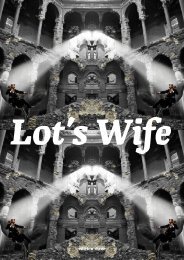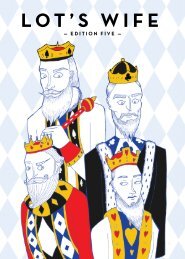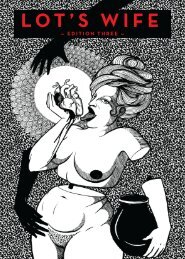Lot's Wife Edition 8 2013
Create successful ePaper yourself
Turn your PDF publications into a flip-book with our unique Google optimized e-Paper software.
SCIENCE<br />
public concern continue to be consciously ignored by Monsanto. This<br />
lack of certainty surrounding the existence or nonexistence of longterm<br />
environmental risks, which potentially outweigh the acclaimed<br />
advantaged of yield-enhancing GM technology, makes it difficult for<br />
the public to direct their outrage. Until such a time as Monsanto gives<br />
me reason to believe – despite my antipathy of their ruthless crowding<br />
out of small-holder farms and monopolisation of seeds – that the social<br />
and environmental benefits of genetically modified food outweighed the<br />
disadvantages then I would concede that there was no reason to reject<br />
GM food production on the grounds of sustainability. Of course, this<br />
would not justify its business ethics, but that is a topic warranting its<br />
own discussion. Until then, I shall continue to employ the precautionary<br />
principle with respect to my diet. Strictly local or organic puh-lease.<br />
SCIENCE LESSONS FROM...<br />
GAME OF THRONES<br />
Chris Pase<br />
The fictional world of Westeros where Game of Thrones is set is subject<br />
to unusual seasonal patterns. We’ve been warned: winter is coming, and<br />
it could last generations. Seasons are mostly controlled by a planet’s tilt<br />
towards the Sun, with Uranus’ North Pole pointed towards the Sun for<br />
42 years and then away from it for another 42. Unusually long seasons are<br />
definitely possible, but the seasons on Westeros seem to arrive unpredictably<br />
and vary dramatically in length. Astrophysicist Greg Laughlin of The<br />
University of California says a ‘wobbly’ axis like the one on Mars can vary<br />
season length, but only makes gradual changes over thousands of years,<br />
not the random fluctuations seen on Westeros. Laughlin has suggested<br />
that if Westeros were part of a multi-planet system, with its orbit being<br />
pulled out and affected by the planets around it, wild season change could<br />
occur. Similarly, a group of graduate students from John Hopkins University<br />
in the United States have released a research paper concluding that<br />
Westeros orbits 2 suns; yielding an irregular orbit, meaning it is impossible<br />
to predict the length of seasons.<br />
***<br />
Another weather related phenomenon, the ice wall, seems harder to<br />
explain from a scientific point of view. Over 200m tall and almost 500km<br />
long, the ice wall is an impressive natural defence against the North.<br />
According to Engineer Mary Alibert from the Ice Drilling Program Office<br />
at Dartmouth College, “even at very cold temperatures, large ice masses<br />
deform under their own weight,” let alone “hold its original shape for<br />
thousands of years.” The ice wall is far too big to support its own weight,<br />
with a slope needed to support a structure that high. This means the wall<br />
would be 40 times wider than it is high – still an impressive structure but<br />
slightly easier to scale. Once again gravity spoils all the fun, and with no<br />
evidence to suggest gravity varies greatly between Westeros and Earth this<br />
one has to be put down to the magic that helped create it.<br />
***<br />
The wildfire used in the battle at Blackwater Bay is strikingly similar to<br />
ancient Greek fire, or the modern equivalent, napalm. Greek fire was used<br />
by the Byzantines to sink rival ships, exactly as Tyrion did. Furthermore,<br />
Greek fire was a closely guarded state secret, just as the Alchemist’s Guild<br />
in King’s Landing controlled the creation of wildfire. While the makeup<br />
of Greek fire was lost, it is most commonly believed to be petroleum based<br />
like napalm. All these weapons are activated in two stages; firstly the<br />
delivery of the flammable substances, and secondly a reactant to ignite<br />
the fuel. George R.R. Martin makes his wildfire a little more dramatic,<br />
its haunting green glow turning into an eerie explosive light show. This<br />
colouring wouldn’t be hard to achieve, with compounds such as trimethyl<br />
borate producing emerald flames and copper chloride providing the green<br />
tinge to the liquid.<br />
***<br />
Incest. It appears to be one of Martin’s favourite plot drivers. One of the<br />
sub-characters, Craster, is a wildling who continually reproduces with his<br />
daughters. And their daughters. This means some of his daughters are also<br />
his granddaughters, and sisters with their own mothers. A slightly less<br />
confusing case is Joffrey Baratheon, said to be the love child of his mother<br />
Cersei Lannister and her brother Jaime despite the former being married<br />
to king Robert Baratheon. Robert Baratheon has a host of bastard children<br />
all born to other women, all of which take after his father in having<br />
dark hair. Yet Joffrey has blonde hair (as well as his two siblings) like his<br />
mother and uncle (father?). It is possible that while Robert has dominant<br />
dark hair alleles (groups of genes), these may mask blonde alleles.<br />
However, given none of his bastard children have blonde hair but all of<br />
Cersei’s children do, the odds are stacked against him. That and the scene<br />
where Jamie shows off his swordsmanship to his sister Cersei.<br />
LOT’S WIFE EDITION 8 • <strong>2013</strong><br />
35


















